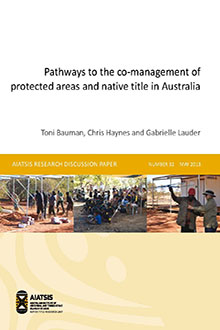Pathways to the co-management of protected areas and native title in Australia
In recent decades, various forms of co-management of national parks and other protected areas1 by governments and Indigenous people have come to the fore. This has occurred as Indigenous peoples have progressively demanded greater access to and decisionmaking power over their traditional lands. The response of governments has also seen the aligning of a number of policy approaches that have contributed to an increase in attention to co-management. In the first instance, there has been a rapid rise in the number of protected areas in Australia since the 1960s, and this is continuing as the Commonwealth Government aims to increase the size of the Australian National Reserve System (NRS) by 25 per cent and Australia’s network of terrestrial protected areas to 125 million hectares by 2013 (Caring for Our Country 2013a).2 In addition, at least 16 per cent of Australia’s land area is now held by Indigenous peoples under a range of tenures, with much of this land being of high biodiversity value (Altman & Kerins 2012). As a mechanism for adding new protected areas to the NRS, the Commonwealth Department of Sustainability, Environment, Water, Population and Communities (SEWPaC) has an Indigenous Protected Area (IPA) program that supports traditional owners of lands or seas who voluntarily dedicate their lands as protected areas to promote biodiversity and cultural resource conservation. IPAs now form the second largest component of the National Reserve System, covering over 3 per cent of Australia and making up 23 per cent of the NRS (SEWPaC 2013b).
